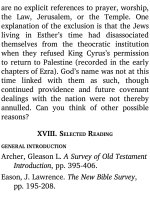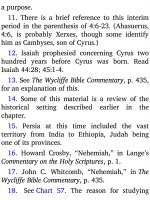Jensens survey of the old testament adam 522
Bạn đang xem bản rút gọn của tài liệu. Xem và tải ngay bản đầy đủ của tài liệu tại đây (116.86 KB, 4 trang )
much space in this short epistle to defend
his ministry. Just what the apostle said
about himself is the main subject of chapters
1 and 2.
Review the threefold ministry of Paul to
the Thessalonians, as shown on Chart 90.
Observe the following in the Bible text:
1 . Ministry in person (1:2—2:16). Observe
the repeated pronoun “you” in chapter 1,
and “we” (referring to Paul) in chapter 2.
Both chapters are Paul’s testimonies. What
are his main points?
2 . Ministry in absentia (2:17—3:13). Paul
regrets that he cannot be with the
Thessalonian Christians in person for the
time being. What two things does he do for
them?
3 . Ministry by epistle (4:1—5:28). At 4:1
Paul begins especially to exhort the
Thessalonians concerning their behavior in
daily living. Paul never wrote a letter
without appealing for Christian conduct that
magni ed Christ and pleased God. The
apostle here reminds the Thessalonians that
he had earlier instructed them about these
things when he was with them. Now, he
writes, “keep on” living in that way, but
“doing still better” (4:1, Berkeley). Healthy
Christian living is not static; it is always
dynamic. Christians are to keep growing,
moving, abounding. As someone has said,
“There is no nality in practical holiness
while the Christian remains on the earth.”
VI. THEME, KEY WORDS AND VERSES FOR 1
THESSALONIANS
How would you identify the theme of 1
Thessalonians? Observe the theme identi ed
on Chart 90 as a title. Note the key words
and verse shown also on the chart. Compare
these with your own choices made on the
basis of your survey.
VII. APPLICATIONS FROM 1 THESSALONIANS
Paul’s rst letter to the Thessalonians
abounds in practical applications. Re ect on
the things you have learned here about the
following:
1. the comfort and hope of Christ’s return
2. endurance in affliction
3. faithful Christian service
4. maturing as a Christian.
VIII. REVIEW QUESTIONS ON 1 THESSALONIANS
1. On what missionary journey did Paul
rst visit Thessalonica? Name two nearby
cities evangelized about the same time.
2. What was the strategic location of
Thessalonica?
3. Describe the average Thessalonian in
Paul’s day.
4. What was the religious situation in
Thessalonica when Paul arrived at the city?
5. What were the main points of Paul’s
rst sermons in the synagogue? What were
the results of this ministry?
6. Where was Paul when he wrote 1
Thessalonians? Why did he write the letter?
7. Name some prominent subjects in this
epistle.
8. What are some of the letter’s
characteristics?
9. When did Paul write 1 Thessalonians,
as compared with his other epistles?
10. What key doctrinal passage appears in
this letter?
11. Where does the second division of a









